Overview
This briefing was presented at the Space Access ’99 conference in Phoenix, AZ. Permission to use all pictures was granted by the respective owners.
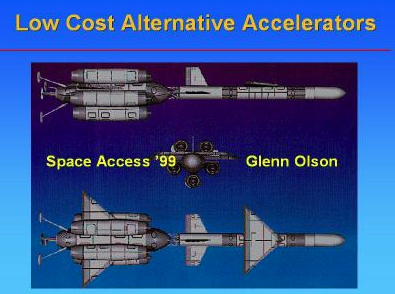
The goal of this presentation was to show a) that rockets are nearing their limits of efficiency and b) that there are alternatives which have the ability to far exceed the efficiency and economics of rockets.
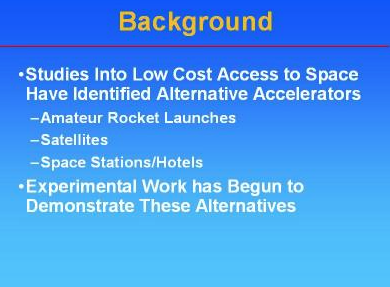
These alternative accelerators have application to amateur rockets, placing satellites in orbit, and transporting people and materials to space stations and space hotels. Research has been conducted in the way of literature searches, interviews with experts, and even some garage-level experimental work.

The Technology S-Curve refers to the development and improvement of a technology. As the technology improvement starts to level off then a new technology is needed to make significant further advances. For example, propellers were first used on airplanes by the Wright Brothers. These were not very efficient but were effective. Propellers improvements advanced quickly and by the early 1940s they were moving aircraft through the air at high subsonic speeds. But, advances were becoming more difficult and expensive and propellers could not go supersonic. The upper end of the S-Curve had been reached.
About 1940 jet engines were being developed and would soon replace propellers on most high performance aircraft. There is still propeller research ongoing but the improvements are only minor.
Spacelift propulsion is also at the top of the S-Curve. Commercial rockets are already at the 98% efficiency level and each incremental improvement is small and at great expense. Because the payload of a rocket is so small compared to the gross liftoff weight (GLOW) small improvements in rocket efficiency appear to have large gains but, in fact, such improvements are as limited as the rocket improvements. Some folks say that there are still improvements in materials to be made but, these too are near the top of their technology S-Curve.
Alternatives to rockets have existed for many years. For example, ramjets have been operated for nearly 70 years. At speeds above Mach 0.5 ramjets have a more fuel efficient than rockets. A ramjet has a theoretical Isp of 2,400 sec while a LOx/kerosene rocket is limited to about 350 sec. And ramjets have not reached the top of their technology S-Curve.

This chart shows how much of its mass a rocket consumes in the early half of a launch. Just getting to Mach 2, about 9% of Low Earth Orbit (LEO) velocity, a rocket consumes about 28% of it’s mass in fuel. By Mach 5 it has used over 50% and by Mach 7 about 2/3 of its mass. By using cheaper alternatives during this initial portion of the launch a considerable savings can be achieved.
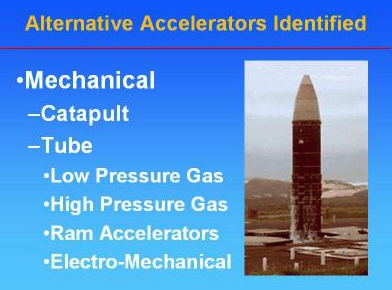
A number of alternative accelerators were looked at. Mechanical accelerators are particularly attractive because much of their mass is stationary and none of it has to reach very high speeds. They also tend to be very energy efficient.
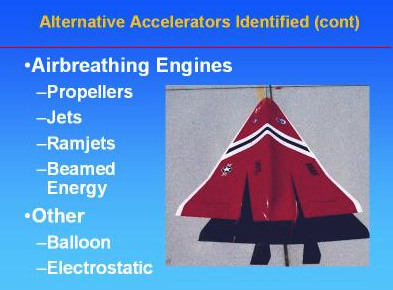
Likewise, airbreathing engines have much higher Isps than rockets. They provide thrust at zero speeds but are limited in top speed. A recent effort led by the Japanese developed a design and subscale testing of a Mach 5 turboramjet for commercial passenger service. It remains to be seen if it will ever go into production.
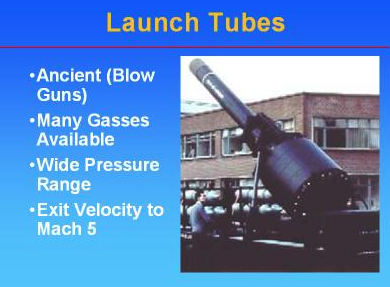
At a Maglev conference several years ago NASA HQ was proposing using magnetic levitation and acceleration. The idea was to cut a tunnel through the top of a mountain in Colorado and install the electromagnetic components. The rocket was to ride on a sled and be ejected at high speed and elevation. The cost of building such a launcher was in the billions. One of the attendees in the back of the room suggested, instead, that it would be much cheaper and easier to pressurize the bottom of the tunnel and blow the rocket out.
Pneumatic launchers have been around since ancient times. There are a wide variety of gasses available so the characteristics can be tailored. With gasses such as helium exit velocities of Mach 5 can be achieved. Even steam heated air can achieve Mach 2. The sonic boom at ground level, though, may annoy the environmentalists and anyone within 50 miles.
The pictured launcher is a LoCat pneumatic gun. It launches a high explosive charge at about Mach 1 into snow drifts. The charge then detonates setting off controlled avalanches.

A perrenial fall sport is the Punkin Chunkin contest . One of the classes for shooting pumpkins is the “Unlimited Air Class” or pneumatic cannon. www.punkinchunkin.com
An example of how effective a pneumatic gun can be for amateur rocketeers is shown here.
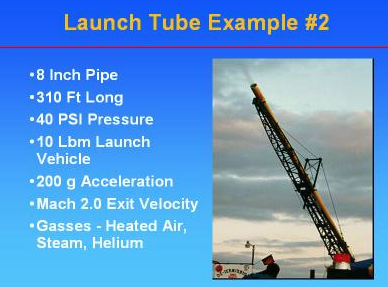
Large diameter pipes are relatively common. The water line into New York City ranges from 10 to 20 feet in diameter and is hundreds of miles long.
In this example a large passenger spaceship, about the diameter of a Lear Jet, is accelerated to Mach 2, a good speed for ramjet takeover. The launch tube is 4 miles long, only a little longer than a major runway. The maximum acceleration for the trip into space is 3 g, what the shuttle astronauts currently see.
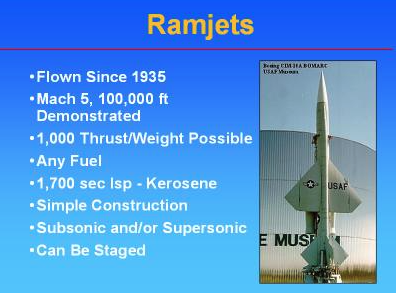
Ramjets were particulary interesting because of their simplicity and range of speeds. Ramjets technically operate (i.e. produce thrust) at any velocity except zero. Efficiency and net thrust vary with speed. By Mach 0.5 they produce about 2 lbf/sq-in of combustion chamber cross sectional area and their efficiency is equal to that of a rocket for the same fuel. At around Mach 2.5-3.5 they reach their peak performance with about 20 lbf/sq-in and 2,400 seconds Isp (theoretical). All of the documents I’ve read and experts I’ve talked to say that Mach 7 is achievable with positive net thrust. About half extended that to Mach 9 and one extended that to Mach 11 or higher. The open literature describes at least one ramjet that operated to Mach 5.5 when the fuel controller stuck full open.
A variety of catapults were looked at, this being the Trebuchet. The Navy uses steam catapults aboard aircraft carriers and has begun studies into using electromagnetic catapults. The White Sands Missile Range sled track, which uses a rocket to accelerate objects to hypersonic speeds, is also looking at upgrading to electromagnetics.
Lacking funding to do full-up engineering analyses I have been conducting garage level experimental work. My first such project was to build a VTVL, model airplane technology, first stage called “Small Pogo.” Liftoff was never achieved before the project was set aside to work on the “Amateur Rocket Launch Assist (ARLA)” project. This has the goal of launching an amateur ramjet to Mach 5 at 100,000 ft. This is a picture of combustion chamber/flame holder work for ARLA.
The Tri-Mode Launch Concept combines two alternative accelerators with rockets to offer a launch system suitable for passenger service to space stations and space hotels.
The Tri-Mode would be particularly applicable to the proposed Japanese space hotel industry. The pneumatic tube could be built between two islands with the passengers boarding on one and the exit on another. The majority of the four-mile long tube would be under water where land is not at a premium. At no time would the acceleration exceed 3g, which is what the Space Shuttle astronauts endure. Launch would begin nearly horizontal then climb to about 45 degrees, much more airline-like than vertical launchers.
By using slightly more sophisticated ramjets the air breathing portion could be expanded to Mach 0.5 to 7.0. This would increase the vehicle size but reduce the mechanical launcher to 1/4 mile which could be done with a sled rather than a tube.
Rockets are technologically dead-ended while alternatives have yet to be adequately explored and have much more promise for future improvements. Such alternatives have applicability to both commercial and amateur applications. Some development will be required to adapt these alternatives but these are simple engineering tasks, not “rocket science.”